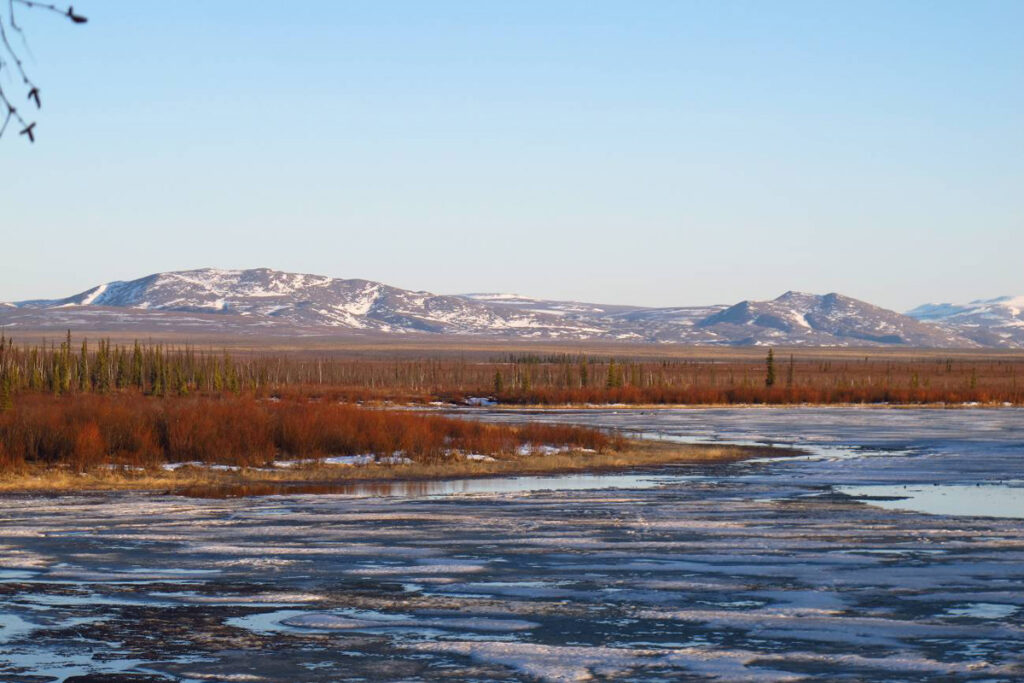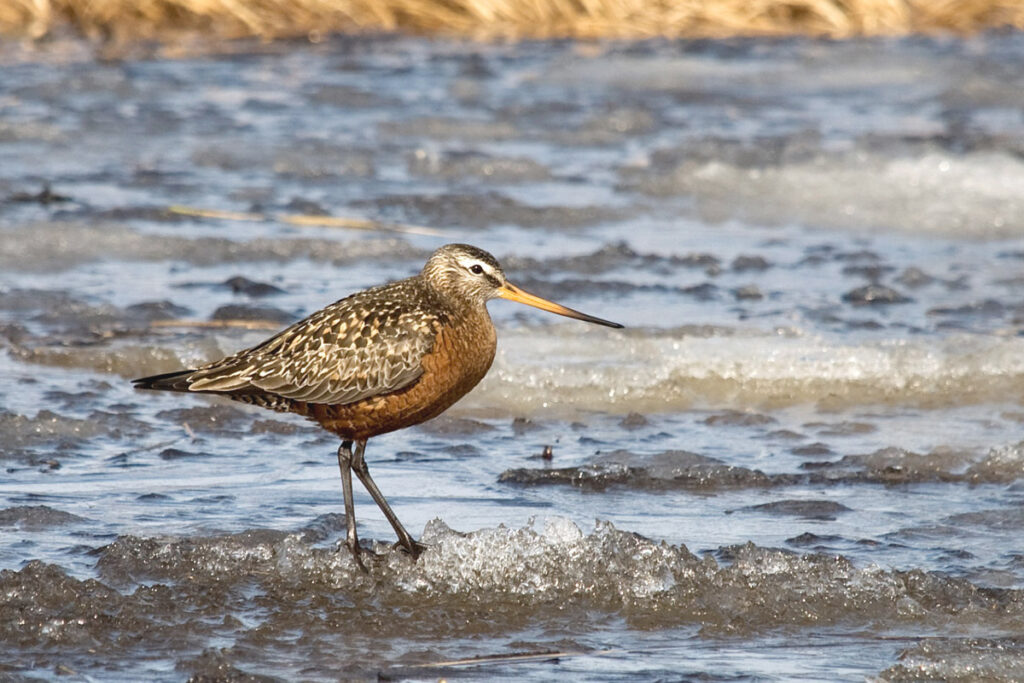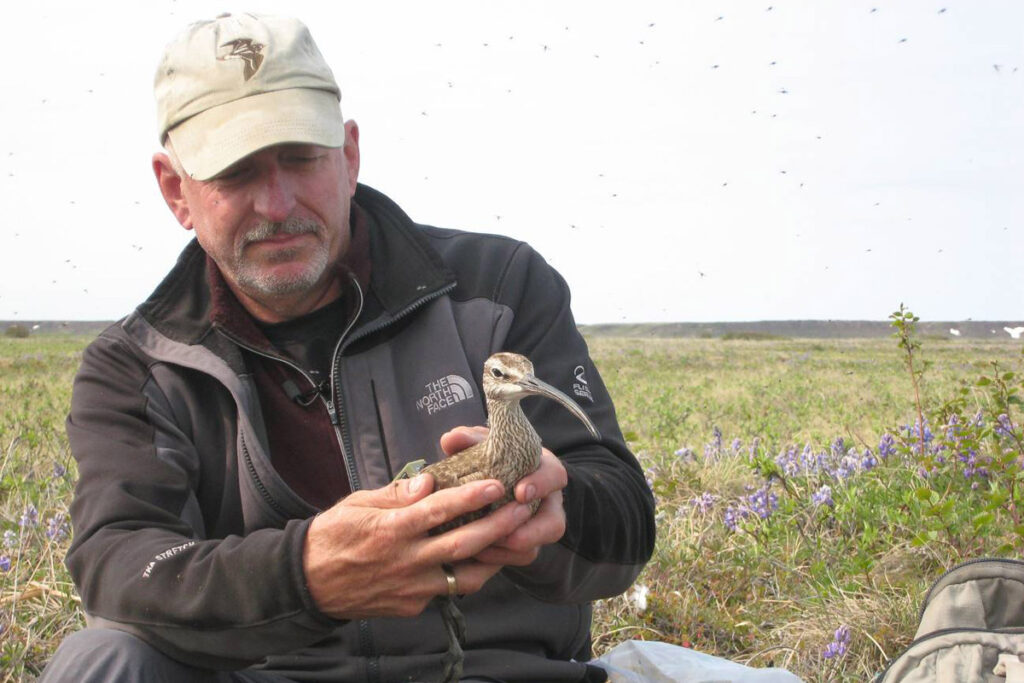In February 2008 my boss offered me the chance to “spring out” at our U.S. Fish and Wildlife Service administrative cabin on Kanuti National Wildlife Refuge in north-central Alaska. Having visited the cabin occasionally for brief summer stints in my previous five years with the Refuge, I had not been there in the boreal spring to observe the many changes during this special season, like the break-up of ice on the lakes and Kanuti River, arrival and display period of migratory birds, and leaf-out of the deciduous trees. Arriving by ski-plane in mid-April and departing by floatplane in late May would finally give me ample time to explore this habitat-rich area and fully document the locally breeding birds, as well as passing migrants.
On 6 May I heard my first Whimbrel (Numenius phaeopus) and on 8 May my first Hudsonian Godwit (Limosa haemastica), both in tundra just south of Kanuti Lake. Over the next two weeks we made regular forays into the tundra and observed both shorebird species in courtship display. While a predecessor had observed a pair or two of Whimbrels just three kilometers away from the cabin a decade before, Refuge staff historically had not been aware of this co-located population of Whimbrels and Hudsonian Godwits. To better quantify shorebirds at this site, I did a circuit of 20 point counts (500-m intervals) on 19 May and recorded Whimbrels and Hudsonian Godwits on 20 and 6 points, respectively.
At the time, shorebird researchers at the U.S. Geological Survey’s (USGS) Alaska Science Center (led then by principal co-investigator Bob Gill) and PRBO Conservation Science (now Point Blue, and led then by principal co-investigator Nils Warnock) were studying the migrations of Alaska’s curlews and godwits (tribe Numeniini) as part of their Pacific Shorebird Migration Project so I called Bob Gill about the exciting godwit discovery. While Bob concurred that the godwit breeding was indeed noteworthy, he was more interested in the Whimbrels, as they were the next species whose migration ecology would be explored with satellite telemetry. He advised me to re-survey in mid-June, following the hatch of Whimbrel and godwit nests, confirm breeding, and obtain a better estimate of the number of Whimbrels. We re-surveyed on 17 June and documented no less than 9 Whimbrel pairs or family groups and 11 transients, and 10 pairs of Hudsonian Godwit, including the first documented chicks for the Kanuti River watershed. We also “rediscovered” two pairs of breeding Whimbrels in the same tundra patch where staff had documented them a decade ago. With these results, Bob deemed that there were sufficient numbers of Whimbrels to use the Kanuti Lake area as one site for deploying 15 satellite transmitters in 2009. Little did I know it at the time, but this breeding population of Whimbrels would eventually serve as the study subject of my Master’s thesis!
I again sprung out at the cabin in 2009 with the intention of locating Whimbrel nests to expedite capture of birds at late hatch in mid-June by the incoming USGS crew. By late May I had located about 16 nests. I happily notified Bob Gill about how we had at least twice as many birds as we had transmitters. The Whimbrel crew—Bob, Dan Mulcahy, Lee Tibbitts, Dan Ruthrauff, and super-volunteers Sarah Warnock and Nathan Senner—arrived as planned and we spent the first day observing how the nesting Whimbrels had fared since I’d first located their nests. Most pairs were still incubating and we even found a few more nests. Over three days, two-person crews captured one or both of paired Whimbrels at their nests and we deployed five surgically implanted transmitters per day. The 15 Whimbrels equipped with transmitters resumed incubation duties and we humans departed Kanuti Lake to follow their subsequent migrations via satellite telemetry.

We expected the battery life for these implanted transmitters to generally cover the southbound migration period from Alaska to the birds’ ultimate nonbreeding grounds. For a refuge biologist like myself, to “see” via remote tracking so many of Kanuti’s satellite-tagged Whimbrels stopping and staging in other national wildlife refuges across Alaska (e.g., Alaska Peninsula, Innoko, Koyukuk, Selawik, Togiak, and Yukon Delta refuges) along the way was gratifying, and demonstrated how important these conservation lands are to these long-distance migrants. And while we had only tagged 21 birds at Kanuti (6 with just leg flags), we received occasional news of public sightings elsewhere, including from observers in southwestern Alaska and central Chile. And nothing was more fun than to have co-author Lee Tibbitts call me at Kanuti Lake on 14 May 2010 to tell me to be on the lookout for male “03,” so named for the unique numeric code engraved on his leg flag. Having spent the boreal winter in Ecuador, 03’s satellite tag indicated he was migrating through south-central Alaska; just the next day, I located him on his breeding territory!
The study continued in 2010 and the researchers chose to deploy 16 transmitters on Whimbrels at an Arctic tundra site near the Colville River in northern Alaska to compare with the Kanuti subarctic boreal site. The crew was able to substitute solar-powered external tags for implanted transmitters on most of the Colville Whimbrels. Whimbrels from the two study sites visited all countries with coasts along the Pacific Flyway, and made extensive use of irrigated croplands during migratory periods, but preferred coastal sites during the nonbreeding period (i.e., boreal winter). The tagged Whimbrels exhibited highly consistent timing of individual movements, but also strong inter-individual variability. Further, Whimbrels showed strong interannual fidelity to staging sites used in preparation for long (>72 hours duration) migrations, but little fidelity to stopover sites used prior to shorter migratory movements. Our results appear in the article, “Diverse patterns of migratory timing, site use, and site fidelity by Alaska-breeding Whimbrels,” authored by Dan Ruthrauff, myself, Lee Tibbitts, Nils Warnock, and Bob Gill in the June 2021 issue of the Journal of Field Ornithology. For Whimbrels that bred so close together (at times less than 100 meters between nests), we marvel at their ultimate use of so much of the “western” Western Hemisphere during their full annual cycles…and we are rightly humbled by how many of us from Alaska to Chile are integral to their conservation.
The results of this study were recently published in the Journal of Field Ornithology:
Ruthrauff, D.R., C.M. Harwood, T.L. Tibbitts, N. Warnock, and R.E. Gill. 2021. Diverse patterns of migratory timing, site use, and site fidelity by Alaska-breeding Whimbrels. Journal of Field Ornithology. https://doi.org/10.1111/jofo.12365.
Guest post by:
Chris Harwood
U.S. Fish and Wildlife Service
Kanuti National Wildlife Refuge
Fairbanks, Alaska
Header photo: Whimbrels nearly always flush early and attack-mob predators and intruding researchers so photographing an incubating bird at close range is rare. USFWS photo by Chris Harwood.




